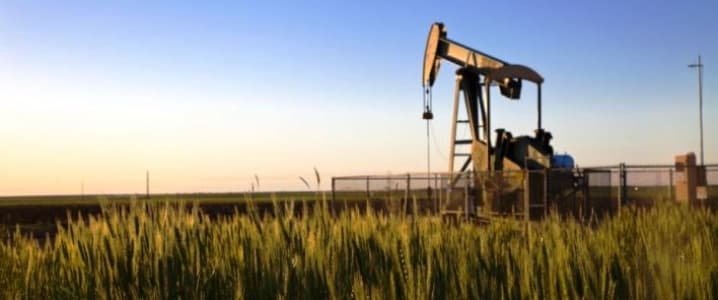The Permian basin is starting to see decline rates from shale wells accelerate, a trend that could be the result of too much drilling.
Shale wells suffer from steep decline rates. A rush of output occurs at first, but almost immediately after the well comes online, the flow rate drops off precipitously. And within just a few months the well is a shadow of its former self. That is typical.
But putting a bunch of wells close to each other can induce even steeper decline rates than normal because they can rob pressure from each other. If that occurs, the wells can suffer irreparable damage, and ultimately, the volume of oil and gas that can eventually be recovered could potentially be permanently diminished.
Such a scenario appears to be playing out in the U.S. shale patch, with the white-hot Permian, in particular, falling victim to what is a byproduct of such a massive boom in activity. Bloomberg reports that the decline rate from “legacy” wells – those already online – is accelerating rapidly, the consequence of over-drilling in certain areas.
In fact, the legacy decline rate in the Permian has accelerated from around 100,000 bpd month-on-month in 2015 and 2016, to a month-on-month decline of 154,000 bpd most recently. In other words, the Permian will see legacy wells lose 154,000 bpd from July to August, which means that shale drillers will have to drill at least as much just to stay flat. The EIA projects that the industry will add 218,000 bpd of new gross supply in the Permian in August, leading to a net gain of 64,000 bpd.
Related: How Will The EU Respond To Fresh US Sanctions On Russia?

(Click to enlarge)

(Click to enlarge)
Other shale basins are seeing their decline rates rise as well. The Eagle Ford’s legacy decline rate has jumped from 80,000 bpd a few months ago to 136,000 bpd in August.
Of course, legacy decline rates always increase when more shale wells come online. It’s just a numbers game. More wells in production means that there are more wells that will enter into decline. In that sense, the higher rates overall decline in the U.S. shale patch are predictable and understandable.
But a new report from Horseman Capital Management Ltd., and cited by Bloomberg, says the decline rates are deeper than usual because drillers are placing too many wells in close proximity to one another. The wells then kill pressure in each other, lowering the amount of oil that can be recovered from them. "New well production is increasingly cannibalizing legacy production," Russell Clark, investment manager at Horseman Capital Management, wrote in a new report, cited by Bloomberg. "The decline rate looks to be accelerating."
Shale companies often trumpet their ability to tweak their drilling practices in order to cut costs, boasting about “drilling efficiencies” that have allowed them to lower their breakeven prices over the last three years. But one of those practices is putting so many wells close together, a practice that was thought to squeeze more oil out of the ground at lower cost. However, while the costs might indeed remain low, this new evidence suggests that cramming wells close too close together could be eating into their own potential production levels.
Related: Barclays: Oil Prices To Drop This Quarter
More evidence of trouble in the Permian came from the quarterly data from Pioneer Natural Resources, considered one of the top drillers in the Permian. Pioneer reported higher natural gas-to-oil ratios in its production than it expected. As oil fields age, Reuters reports, they tend to produce relatively more gas than oil. Pioneer’s surprise at the higher gas coming from its wells raised some alarm from investors, who questioned company executives on a conference call about falling well pressure. Pioneer’s management tried to assuage investors by saying that the higher gas-to-oil ratio has more to do with simply more gas coming out of the ground, rather than less oil. In other words, they say, there’s nothing to see here.
ADVERTISEMENT
Perhaps. But the legacy decline rates are accelerating at a dizzying pace. Across the top shale basins in the country, including the Permian, Eagle Ford, Bakken, Haynesville, Marcelles, Niobrara and Utica shales, the oil legacy decline rate has hit 350,000 bpd. Again, that means, from July to August, those basins lost 350,000 bpd of production. Of course, the rate of drilling is so aggressive that the industry still added 113,000 bpd of production on net, but it took a lot of new wells to more than offset the decline.
Shale output is still on an upward trend, but if the industry can’t keep up on this accelerating treadmill, the legacy decline rates will catch up to them.
By Nick Cunningham of Oilprice.com
More Top Reads From Oilprice.com:
- Oil Prices Rise As The U.S. Rig Count Falls
- Eni’s Arctic Risk Could Pay Off
- Venezuela’s Demise Is A Geopolitical Litmus Test For The U.S.



















In 2008, when US C+C production averaged 5 million bpd, the decline rate from existing production was probably about 5%/year, which would be a volumetric rate of decline of 0.25 million bpd per year in existing production.
Currently, I think that a plausible estimate is that the rate of decline in existing US C+C production is at least 15%/year, which implies that we need about 1.4 million bpd of new C+C production every year, just to offset declines from existing wells. Or, based on the foregoing, over the next seven years the US has to put on line roughly the equivalent of all of Saudi Arabia's current C+C production, just to maintain current US production.
https://www.reuters.com/article/us-global-oil-idUSKBN1AN02R
I wonder?